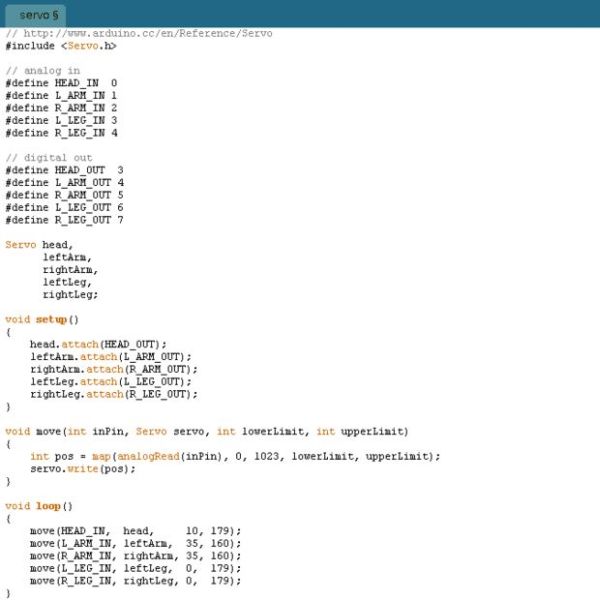Servos are surprisingly easy to use. Even more so than simple DC motors and steppers when you have a microcontroller. In this instructable we’ll use a ‘duino to drive five servos which will control a doll’s limbs and neck.
I bought the servos at HobbyPartz for a couple bucks apiece and found the doll at a swap meet for a dollar. The doll says 1967 Mattel on the back and I later learned she is a See ‘n Say type doll. The hard plastic body was important for a successful installation.
Step 1: Dismemberment
Pop off the arms and use a coping saw to split open one side. Then crack open the other side and remove the guts. Be careful along the way to ensure that everything can be put back together after. I also spent at least 20 minutes trying (and failing) to get the inner workings functional.
Step 2: Turning Heads
The Neck
First dry fit the server horn in the neck and trim it as needed. The servo needs a base to stand on so we’ll use some Mighty Putty (aka Epoxy Putty) to fill in the neck.
This stopper will serve as a base for the servo which turns the head. It must stick to one half of the body but not the other to allow the torso to be opened and closed freely. Use a little petroleum jelly on one half of the torso and the servo horn to prevent them from sticking.
Fill the neck with putty while focusing on how the torso comes apart. Allow the putty to cure for a minute or two to eliminate some of the tackiness. Then press the servo horn into the neck to create a firm footing for the servo.
Finally remove the servo and top half of the torso. Allow the putty to cure further while testing the fit a few times before it cures completely. The putty can be filed and sanded after it’s hard but it’s much easier to adjust it prior.
Step 2: Turning Heads
The Neck
First dry fit the server horn in the neck and trim it as needed. The servo needs a base to stand on so we’ll use some Mighty Putty (aka Epoxy Putty) to fill in the neck.
This stopper will serve as a base for the servo which turns the head. It must stick to one half of the body but not the other to allow the torso to be opened and closed freely. Use a little petroleum jelly on one half of the torso and the servo horn to prevent them from sticking.
Fill the neck with putty while focusing on how the torso comes apart. Allow the putty to cure for a minute or two to eliminate some of the tackiness. Then press the servo horn into the neck to create a firm footing for the servo.
Finally remove the servo and top half of the torso. Allow the putty to cure further while testing the fit a few times before it cures completely. The putty can be filed and sanded after it’s hard but it’s much easier to adjust it prior.
The Head
Now it’s time to mount the servo to the head. The first thing we want to do is remove the scalp. Follow just under the hairline with a razor and remove it completely.
Take a moment to orient the horn so that it has an even range of motion in either direction while it’s oriented perpendicularly to the face. Place the horn in it’s footing and run the wire down the side of the putty. Turn the servo in the direct opposite the wire and make sure it has enough slack to turn completely. Mark the wire and the putty when you’re happy with the positioning.
Make a groove in the putty with a saw so the servo wire can run down the neck and into the body while it’s closed. Next put the servo in the head and feed the wire down through the groove. Close the torso and put the head back on. You should now have head on the body with the motor in the head and the wire running down the neck into a closed torso.

Adjust the head and servo so that they’re lined up. Make sure there’s an even amount of spacing between the servo and either side of the head. Take a measurement of this space and cut a length of 3/8″ dowel. Dry fit the piece of dowel on either side of the head and re-cut if necessary. Cut another piece of dowel the same length once you’re happy with the fit.
Now wedge the pieces of dowel on either side of the servo. Drop a small amount of hot glue on each side where the dowel meets the servo and allow it to dry. Remove the servo with the dowels sticking to it. The dowels should hinge on the small drop of hot glue while maintaining an accurate placement. Take advantage of this hinging effect to apply more glue between the servo and dowels before clamping them together to create a secure, tight fit.
The dowels should now be attached to the servo but not the head. I initially tried gluing the dowels to the head but the glue didn’t stick. Drill a small pilot hole through either side of the dowel. Place the servo back into the head with the horn planted firmly in its footing and use two screws to fasten the dowels to the head. Remove the head from the body and disassemble the torso.
For more detail: Simple Animatronics with Servos and Arduino

